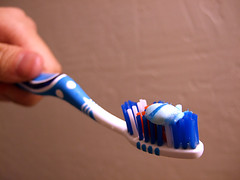
Once upon a time, the choice was quite simple, but today, you must weigh your options carefully, or you could just consider the findings of coming studies.
The researchers from the Fraunhofer Institute for Mechanics of Materials IWM and the Microtribology Centre tested a wide range of the available toothpastes to create a new and improved way to measure the abrasive nature of the cleaning agents currently available.
Abrasives are an important part of toothpastes as the small particles help to scrape away dental plaque that would otherwise lead to decay. However, as time goes by, too much abrasion can wear away the enamel. The abrasive nature of toothpaste depends on the size, amount and hardness of the particles within it. The degree of abrasion possible with a toothpaste is measured as an RDA level (radioactive dentin abrasion). The current range is thirty to two-hundred. The new measuring methods of this study will make these rating more uniform than they have been in the past.
The test utilized a single bristle and a mixture of toothpaste, saliva, and water to recreate the typical brushing habits of people. Movements were made in both straight lines and circular motions to further mimic daily brushing, but the movements were made up to eight thousand times to measure the impact on the teeth.
This new way of testing toothpastes will provide the mass market a better way to compare those on the shelves today. For more information, continue reading the full article.
Photo by: All the toothpaste you actually need / Kenneth Lu / CC BY 2.0









Leave a Reply
You must be logged in to post a comment.